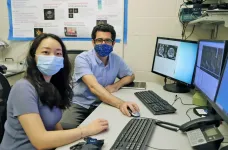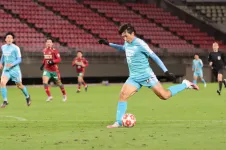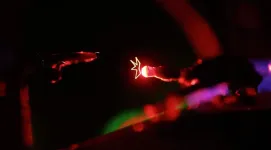(Press-News.org) May 7, 2021 - Among collegiate football players and other athletes, Black athletes recognize fewer concussion-related symptoms than their White counterparts, reports a study in the May/June issue of the Journal of Head Trauma Rehabilitation (JHTR). The official journal of the Brain Injury Association of America, JHTR is published in the Lippincott portfolio by Wolters Kluwer.
"Despite NCAA concussion education requirements for athletes, Black collegiate-athletes were found to have lower concussion symptom knowledge than White collegiate-athletes," according to the new research by Jessica Wallace, PhD, MPH, LAT, ATC, of University of Alabama, Tuscaloosa, and colleagues. The study also finds racial differences in the sources of concussion symptom knowledge.
Need for 'equitable strategies' to communicate concussion information
In the study, 768 collegiate athletes - about 83 percent White and 17 percent Black - completed a standard assessment of concussion symptom knowledge. Participants included 196 football players, of whom 59 percent were White and 41 percent were Black.
Scores on the concussion symptom knowledge questionnaire were compared for Black and White athletes, with adjustment for other characteristics. The athletes were also asked about their sources of information about concussion symptoms.
"Black athletes were more likely to have lower concussion symptom knowledge scores than White athletes," according to the authors. The difference was small: average scores on the 34-point questionnaire were 27.7 for White athletes and 25.9 for Black athletes. However, the between-group difference remained statistically significant after adjustment for other factors. The findings were similar for football players compared to all athletes.
Concussion symptom knowledge varied for a range of sleep, mood, physical, and cognitive symptoms of concussion. In particular, Black athletes were less likely to correctly recognize the symptoms of feeling like "in a fog," nausea or vomiting, and feeling more irritable/angry.
Most athletes identified athletic trainers as a main source of concussion information. White athletes were somewhat more likely to mention other school-based professionals (such as teachers or nurses), online medical sources, or the National Collegiate Athletic Association (NCAA). Black athletes were more likely to cite referees as a source of concussion information.
Basic knowledge of concussion symptoms is fundamental to prompt recognition and reporting of concussions. Studies have suggested that 50 to 80 percent of concussions may go unreported.
In previous studies, Dr. Wallace and colleagues reported racial disparities in concussion knowledge among high school and youth athletes. Concussion knowledge was lowest for athletes attending schools of lower socioeconomic status and without access to athletic trainers.
These differences in concussion knowledge may extend to the college level, the new study suggests. The disparity may be related to historic and systemic bias/discrimination and inequitable access to healthcare and other resources, or to racial distrust in medical resources and healthcare overall. "All of these contributing factors of inequity and disparity at the community level, youth sports level, and high school sports level could impact exposure and/or receptiveness to concussion education materials that may ultimately explain the lower concussion symptom knowledge of Black collegiate-athletes," Dr. Wallace and coauthors write.
The researchers emphasize the need for strategies to ensure equitable access to concussion education and prevention that do not perpetuate disparity: "Moving forward, a conscious attempt is needed to redevelop concussion education initiatives as racially, culturally, and linguistically inclusive, addressing the needs of all collegiate athletes equally and equitably."
The NCAA provides educational resources on concussion: https://www.ncaa.org/sport-science-institute/concussion-educational-resources.
Click here to read "Assessing Differences in Concussion Symptom Knowledge and Sources of Information Among Black and White Collegiate-Athletes."
DOI: 10.1097/HTR.0000000000000672
INFORMATION:
About The Journal of Head Trauma Rehabilitation
The Journal of Head Trauma Rehabilitation is a leading, peer-reviewed resource that provides up-to-date information on the clinical management and rehabilitation of persons with traumatic brain injuries. Six issues each year aspire to the vision of "knowledge informing care" and include a wide range of articles, topical issues, commentaries and special features. It is the official journal of the Brain Injury Association of America.
About the Brain Injury Association of America
The Brain Injury Association of America is the country's oldest and largest nationwide brain injury advocacy organization. Our mission is to advance awareness, research, treatment and education and to improve the quality of life for all individuals impacted by brain injury. Through advocacy, we bring help, hope and healing to millions of individuals living with brain injury, their families and the professionals who serve them.
About Wolters Kluwer
Wolters Kluwer (WKL) is a global leader in professional information, software solutions, and services for the clinicians, nurses, accountants, lawyers, and tax, finance, audit, risk, compliance, and regulatory sectors. We help our customers make critical decisions every day by providing expert solutions that combine deep domain knowledge with advanced technology and services.
Wolters Kluwer reported 2020 annual revenues of €4.6 billion. The group serves customers in over 180 countries, maintains operations in over 40 countries, and employs approximately 19,200 people worldwide. The company is headquartered in Alphen aan den Rijn, the Netherlands.
Wolters Kluwer provides trusted clinical technology and evidence-based solutions that engage clinicians, patients, researchers and students in effective decision-making and outcomes across healthcare. We support clinical effectiveness, learning and research, clinical surveillance and compliance, as well as data solutions. For more information about our solutions, visit https://www.wolterskluwer.com/en/health and follow us on LinkedIn and Twitter @WKHealth.
For more information, visit http://www.wolterskluwer.com, follow us on Twitter, Facebook, LinkedIn, and YouTube.
RNA-based drugs have the potential to change the standard of care for many diseases, making personalized medicine a reality. This rapidly expanding class of therapeutics are cost-effective, fairly easy to manufacture, and able to go where no drug has gone before, reaching previously undruggable pathways.
Mostly.
So far, these promising drugs haven't been very useful in getting through to the well-protected brain to treat tumors or other maladies.
Now a multi-institutional team of researchers, led by Costas Arvanitis at the Georgia Institute of Technology and Emory University, has figured out a way: using ultrasound and RNA-loaded nanoparticles to get through the protective blood-brain barrier and deliver potent medicine to brain tumors.
"We're able to make this drug more available ...
Some meat eaters feel disgusted by meat, according to a new study.
University of Exeter scientists showed food pictures to more than 700 people, including omnivores (who eat meat and other foods), flexitarians (who try to eat less meat) and vegetarians.
About 7% of meat eaters (15% of flexitarians and 3% of omnivores) had a "fairly strong disgust response" to images of meat dishes commonly eaten in the UK, like roast chicken or bacon.
As a group, omnivores rated meat images about twice as disgusting on average as pictures of carbohydrate-rich foods like bread, chips and rice.
Based on the findings, the researchers say harnessing the "yuk factor" may ...
Ikoma, Japan - Many natural compounds have various anti-inflammatory and other beneficial properties that humans have been utilizing for medicinal purposes for hundreds of years. However, the specific molecular mechanisms behind these health-promoting effects are not always clear. One such compound is 1'-acetoxychavicol acetate, or ACA, which comes from the tropical ginger Alpinia plant. Now, researchers from Nara Institute of Science and Technology (NAIST) have identified how ACA can help in the treatment of inflammatory diseases.
In a report published in International Immunology, they found that ACA attenuates mitochondrial damage through decreasing mitochondrial reactive oxygen species (ROS), blocking ...
Scientists from Nanjing University and University of Macau have discovered nano-scaled apoptotic bodies (ABs) as a new brain-targeting drug carrier, bringing new promise for the Parkinson's Disease as well as other brain diseases.
The blood-brain barrier (BBB) is the most restrictive barrier that keeps most biomolecules and drugs from the brain, setting "barriers" for the treatment of cerebrovascular diseases. With the increasingly serious ageing problem, the treatment of brain diseases now faces tough challenges, and therefore efficient brain drug delivery ...
Cosmologists have found a way to double the accuracy of measuring distances to supernova explosions - one of their tried-and-true tools for studying the mysterious dark energy that is making the universe expand faster and faster. The results from the Nearby Supernova Factory (SNfactory) collaboration, led by Greg Aldering of the Department of Energy's Lawrence Berkeley National Laboratory (Berkeley Lab), will enable scientists to study dark energy with greatly improved precision and accuracy, and provide a powerful crosscheck of the technique across vast distances ...
Computer science researchers at the University of Central Florida have developed a sarcasm detector.
Social media has become a dominant form of communication for individuals, and for companies looking to market and sell their products and services. Properly understanding and responding to customer feedback on Twitter, Facebook and other social media platforms is critical for success, but it is incredibly labor intensive.
That's where sentiment analysis comes in. The term refers to the automated process of identifying the emotion -- either positive, negative or neutral -- associated with text. While ...
Tsukuba, Japan - Scientists from the Faculty of Health and Sports Sciences at the University of Tsukuba used aerodynamics experiments to empirically test the flight properties of a new four-panel soccer ball adopted by the English Premier League this year. Based on projectile and wind-tunnel data, they computed the drag and side forces and found that the new ball was marginally more stable than previous versions but may not fly as far. This work may help improve the design of future sports equipment.
Sports players know that millions of dollars in salary and potential endorsement deals can be at stake during each match. Soccer players often complain about the aerodynamic ...
Researchers have traced the remaining last steps of the biological pathway that gives oats resistance to the deadly crop disease take-all.
The discovery creates opportunities for new ways of defending wheat and other cereals against the soil-borne root disease.
The research team have already taken the first step in this aim by successfully reconstituting the self-defence system in the model plant Nicotiana benthamiana.
Further experiments to establish the avenacin biosynthetic pathway in wheat's more complex genome, to test if it will provide the same resistance ...
They may be tiny weapons, but Brigham Young University's holography research group has figured out how to create lightsabers -- green for Yoda and red for Darth Vader, naturally -- with actual luminous beams rising from them.
Inspired by the displays of science fiction, the researchers have also engineered battles between equally small versions of the Starship Enterprise and a Klingon Battle Cruiser that incorporate photon torpedoes launching and striking the enemy vessel that you can see with the naked eye.
"What you're seeing in the scenes we create is real; there is nothing computer generated about them," said lead researcher Dan Smalley, a professor of electrical engineering at BYU. "This is not like the movies, where the lightsabers ...
May 7, 2021 - Early in the COVID-19 pandemic, healthcare systems scrambled to modify patient care processes - particularly when it came to strategies aimed at reducing the risk of hospital-related complications. A look at how one hospital applied its learning health system (LHS) framework to respond to a COVID-19-related increase in hospital-acquired pressure injuries (HAPIs) is presented in the May/June Journal for Healthcare Quality (JHQ), the peer-reviewed journal of the National Association for Healthcare Quality (NAHQ). The journal is published in the Lippincott portfolio by Wolters Kluwer.
"Given the significant challenges ...






